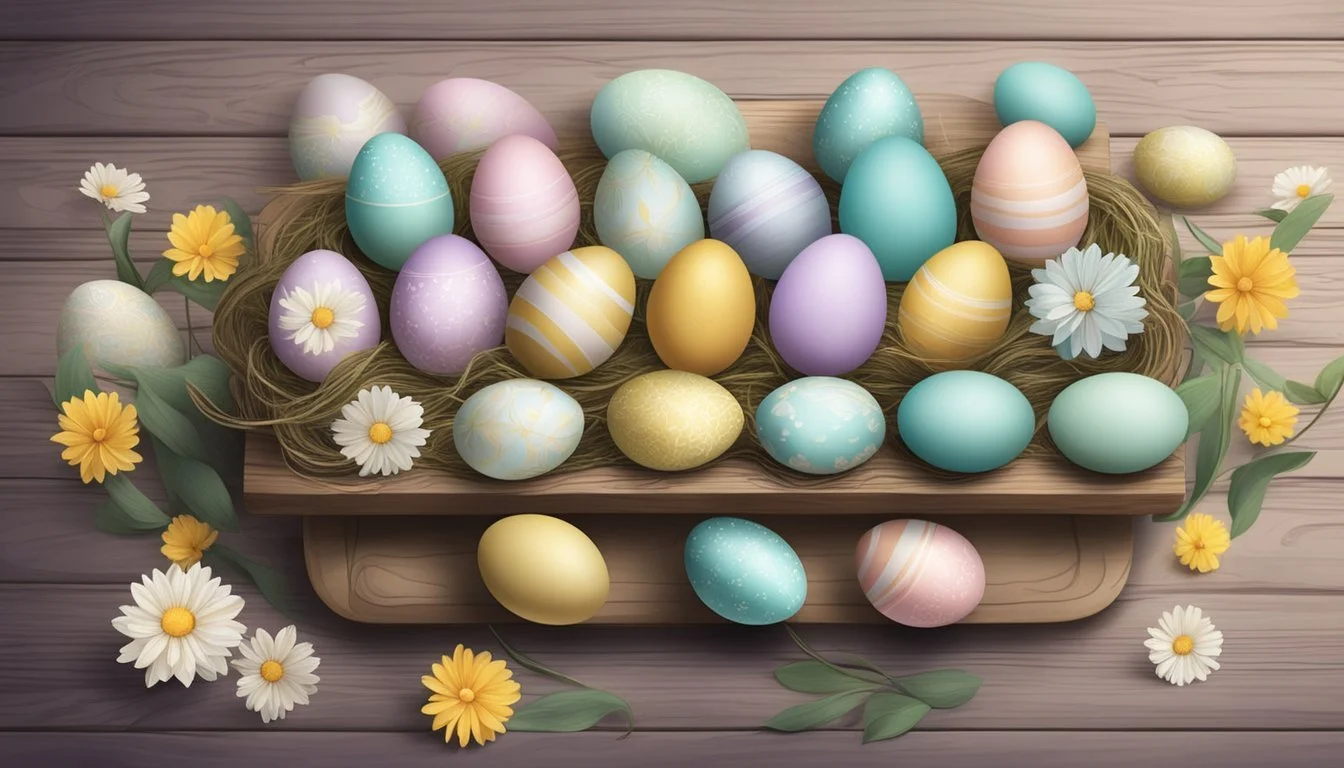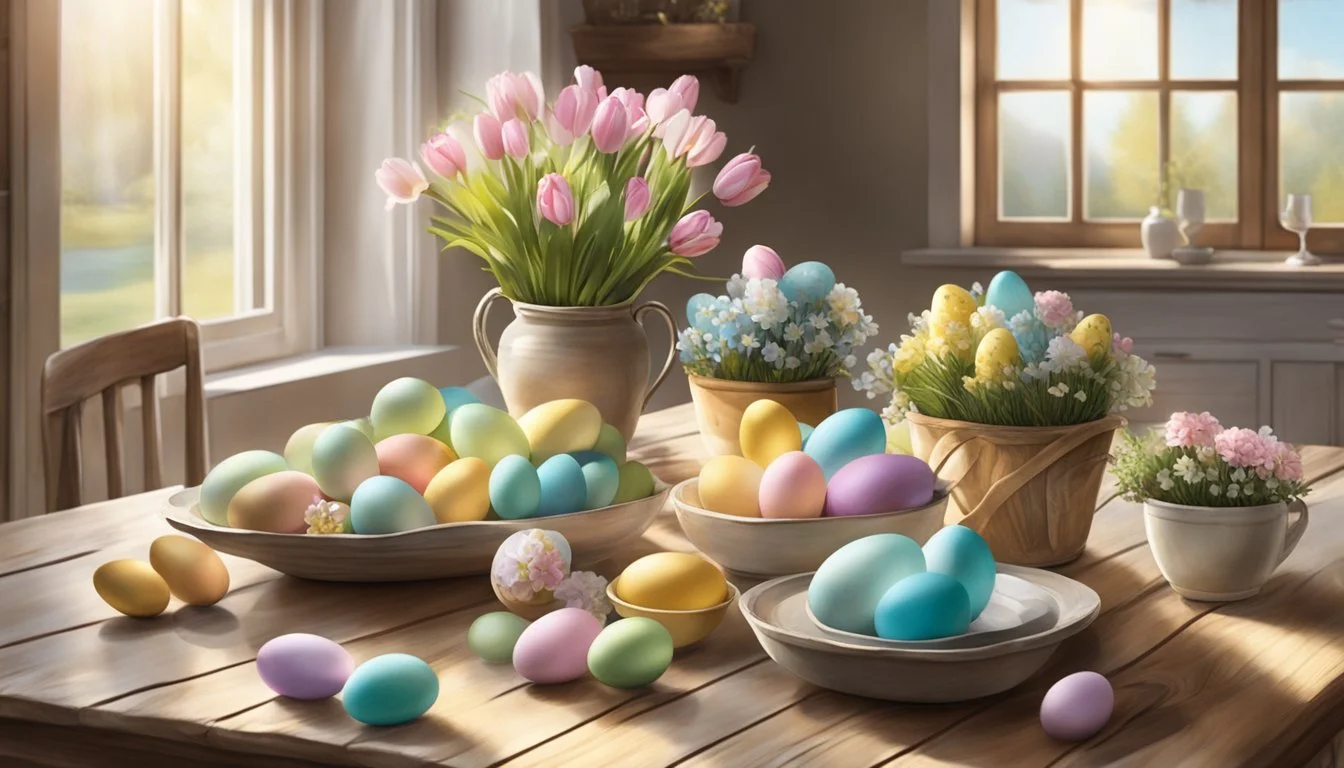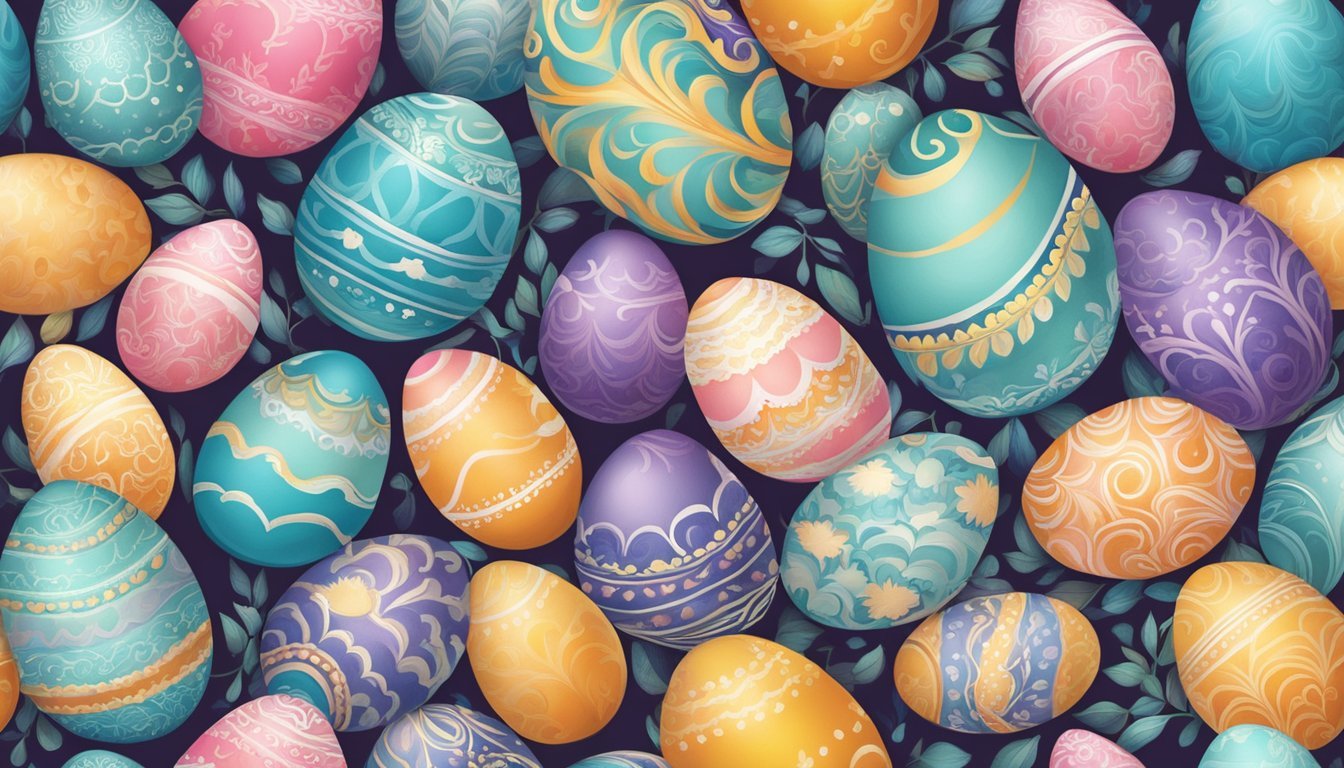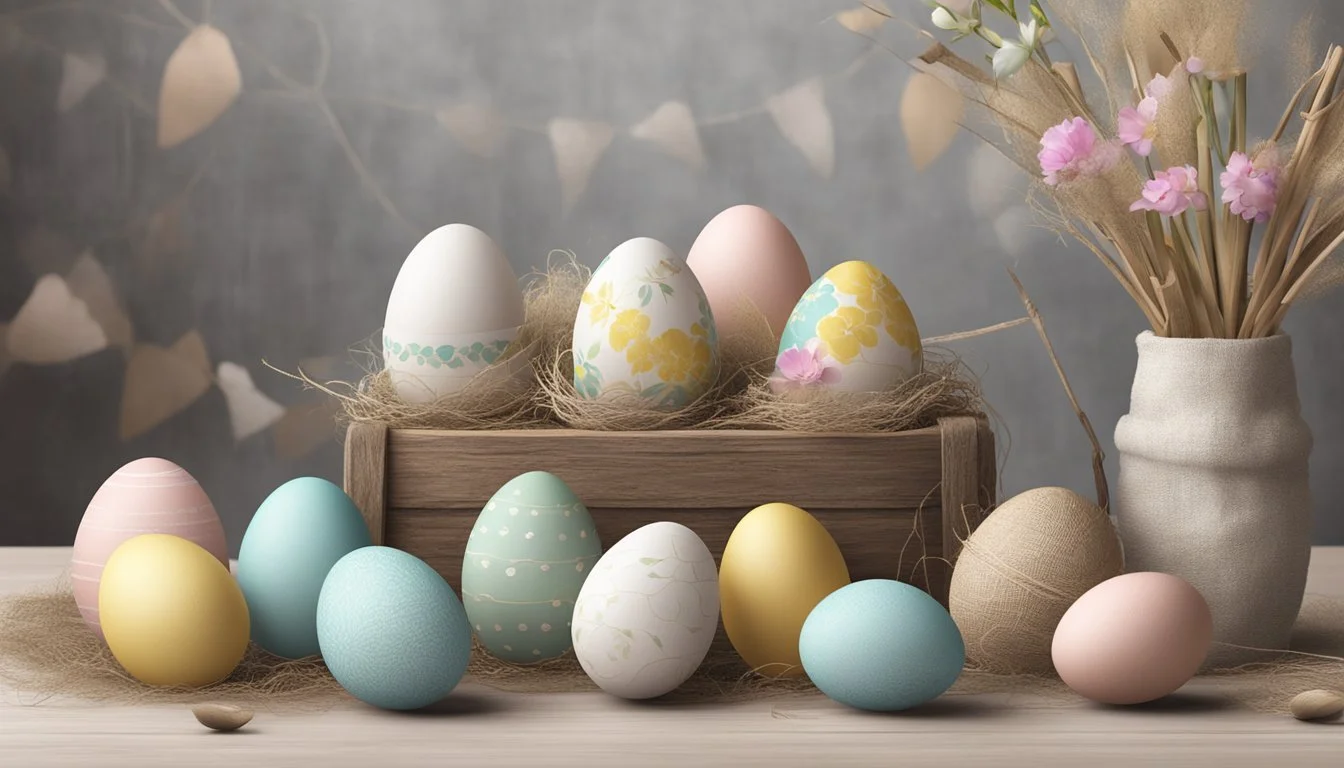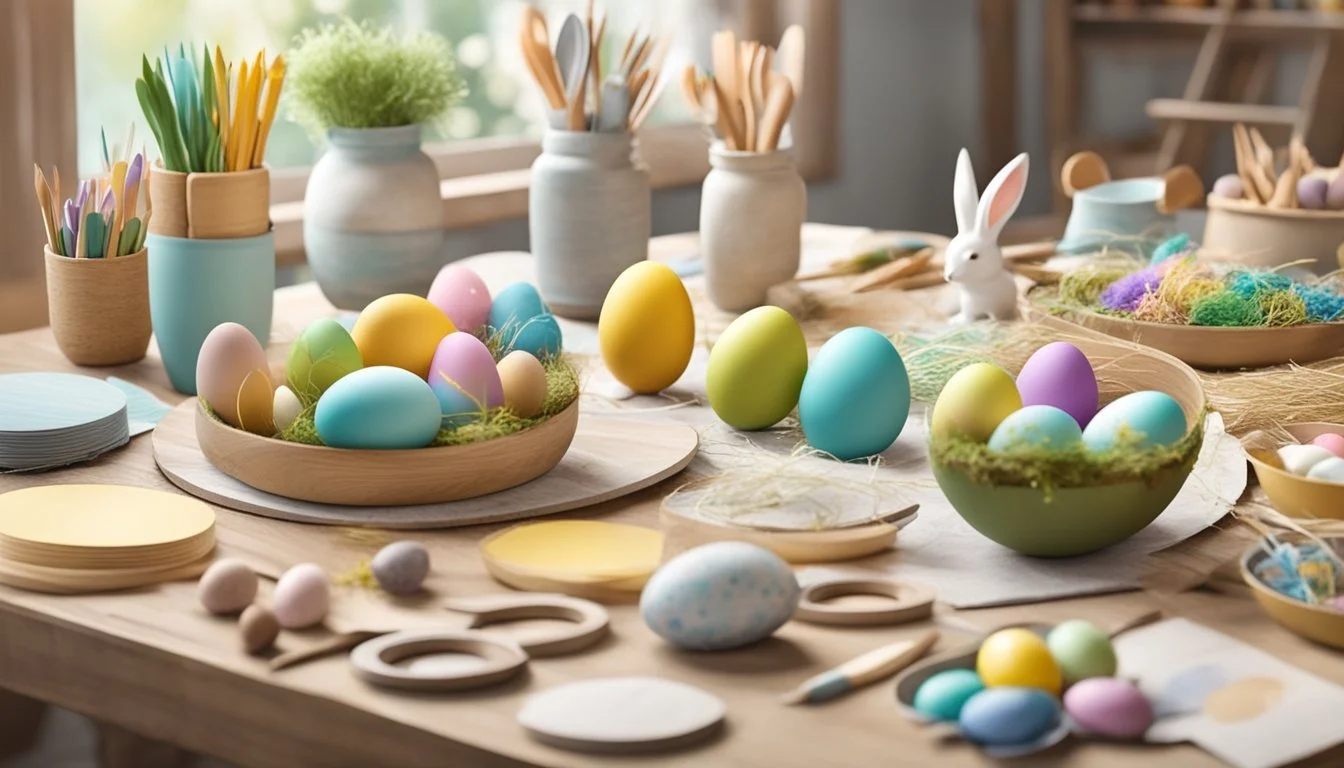Easter Egg Decorating
Country Chic Designs for a Rustic Spring Festivity
Easter egg decorating is a cherished tradition that resonates with the warmth and renewal of spring. It stands as a testament to creativity and family bonding, where each egg becomes a canvas for expression. As the holiday approaches, many seek inspiration for designs that blend the whimsical with the rustic, achieving what's often referred to as ‘country chic’. This design ethos draws from the simplicity and charm of country living, infusing it into the Easter festivities to create a cozy, homespun aesthetic.
Utilizing a mix of materials and textures, country chic Easter eggs incorporate elements like natural dyes, twine, and delicate fabrics. Natural dyes made from onion skins, beet juice, or turmeric give the eggs earthy hues that sit beautifully in a rustic setting. Creative techniques such as stenciling or the application of moss and petite-petaled flowers like paperwhites and daffodils evoke the reawakening of nature during springtime. More than merely decorative, these eggs convey stories and traditions through their designs, making them a focal point in seasonal decor.
The beauty of Easter egg decorating lies in its versatility and the joy it brings to creators of all ages. By embracing country chic designs, decorators honor the roots of pastoral life while adding a personal touch to their holiday celebrations. The final creations are often displayed as centerpieces, tucked into baskets, or even integrated into wreaths, creating an enchanting ambiance that captures the essence of Easter and the tranquility of the countryside.
The Basics of Easter Egg Decorating
Easter egg decorating is a time-honored tradition that invites creativity and celebration. This section covers the essentials, from selecting the perfect egg to the supplies needed and safety considerations.
Choosing the Right Eggs
For Easter egg decorating, individuals can choose from several types of eggs. Traditionalists often use real chicken eggs, while wooden eggs provide a durable alternative that lasts year after year. Wooden eggs are particularly suited for country chic designs, as their smooth surface is ideal for painting and embellishments. For a more modern approach, one might opt for artificial eggs made of plastic or ceramic.
Essential Decorating Supplies
A well-stocked decorating kit is fundamental for transforming plain eggs into works of art. The supplies include:
Paints: Acrylic paint and craft paint are preferred for their quick drying time and vibrant colors.
Brushes: Different sizes for detail work and broad strokes.
Embellishments: Ribbons, lace, or twine to add rustic charm.
Adhesives: Non-toxic glue for attaching decorations.
Preparation and Safety Tips
Before beginning the decorating process, one should always ensure a safe and prepared workspace. Here are key preparation steps and safety tips:
Emptying Eggs: If using real eggs, empty the contents by creating small holes at both ends and blowing out the inside, ensuring a lighter, less perishable egg to decorate.
Surface Protection: Cover the workspace with newspapers or a disposable tablecloth to prevent paint stains.
Non-Toxic Materials: Especially when working with children, it’s crucial to use non-toxic and washable materials for safety.
Drying Time: Allow ample time for painted eggs to dry, avoiding smudges and preserving the design’s integrity.
Country Chic Design Inspirations
Country chic Easter egg designs merge the simplicity of farmhouse aesthetics with the freshness of springtime motifs. This design approach creates an inviting, warm environment that's perfect for celebrating the holiday.
Farmhouse Style Fundamentals
Farmhouse style emphasizes rustic textures and neutral colors. One can achieve this look by wrapping eggs in twine or applying a coat of pastel chalk paint for a matte finish. These materials invariably add an element of country charm to Easter decorations. Using natural dyes from ingredients like onion skins or beet juice can also introduce a subtle, organic color palette synonymous with farmhouse decor.
Spring Decor Motifs
Spring decor is characterized by its use of live plants, floral patterns, and bright but soft colors that embody the season's essence. Incorporating tulips or daffodils into Easter egg displays can bring life to any setting. Additionally, filling clear vases with a mix of Easter candies and placing painted or decorated eggs on top can create a centerpiece that exudes both country chic and springtime joy.
Graphic and Silhouette Designs
For those who favor a graphic approach, using peel-and-stick stencils or tattoo paper transfers with silhouette images of rabbits, chicks, or flowers can add a whimsical touch to the eggs. One can find free graphics online, resize them to fit an egg's surface, and adhere for an artistic Easter egg collection. These graphic eggs become conversation pieces, blending the simplicity of country style with the visual impact of silhouette design.
Advanced Egg Decorating Techniques
Elevate the traditional Easter egg to a work of art with advanced decorating techniques. These methods require precision and patience but result in stunning, showcase-worthy Easter eggs.
Marbling for Easter Eggs
Marbling creates a striking effect on eggs, mimicking the intricate patterns of natural stone. For marbled eggs, colors are swirled together either in a dye solution or using nail polish floated on water. The egg is then dipped in, and as it's removed, a unique marbled pattern adheres to the shell.
Decoupage Easter Eggs
Decoupage allows for detailed patterns and imagery on Easter eggs. This technique involves adhering thin layers of paper — often with intricate designs — to the eggshell using a sealant. Decoupage provides a way to apply elaborate prints and can incorporate fabrics or napkins for a textured look. Crafters should apply a glue solution evenly, smoothing out wrinkles for best results.
Silk-Dyed Egg Artistry
Silk-dyed eggs require silk fabric with vibrant colors and patterns. The material is wrapped around the egg before boiling it. As it cooks, the dye from the silk transfers to the egg, creating complex, tie-dye or batik-like patterns. This process works best with 100% silk, and darker fabrics tend to yield more intense colors.
Unique Embellishments and Variations
When it comes to Easter egg decorations, branching out with innovative techniques can transform the traditional into something truly remarkable. This section explores various methods for adorning eggs, from Washi tape accents to temporary tattoo applications, and even how to achieve speckled and textured effects.
Washi Tape Accents
For an immediate and eye-catching design, Washi tape offers versatility and ease of application. Crafters can cut the tape into various shapes or stripes and adhere it directly to the egg's surface, creating patterns or themed motifs. The tape's adhesive is generally light, making it simple to reposition for the perfect design. Moreover, Washi tape is available in an array of colors and patterns, which provides endless possibilities for customization.
Temporary Tattoo Applications
Temporary tattoos are not just for skin; they can also serve as intricate designs for Easter eggs, creating the "tattoo Easter eggs." Starting with a clean, dry egg, one simply applies a wet cloth over the tattoo paper backing and holds it firmly for about 30 seconds. Once the backing is peeled away, the tattoo design remains, giving the egg a professional and detailed appearance without the need for paints or dyes.
Speckled and Textured Effects
Achieving a speckled texture on Easter eggs brings a sophisticated and natural look. This effect can be created by dipping an old toothbrush in acrylic craft paint and flicking the bristles over the egg's surface, resulting in a fine, speckled pattern. To enhance the tactile experience, layers of paint can be added, or combined with other materials like fine sand or even herbs, rendering a unique, texturized finish. Additionally, the speckling method pairs well with a base coat of a contrasting color to make the "speckled eggs" stand out.
Displaying Your Easter Egg Creations
After crafting beautiful Easter eggs, showcasing them effectively can enhance their visual appeal and add to your Easter decor. Proper display methods not only highlight the craft's detail but also incorporate them into the festivity of your home environment.
Easter Baskets and Wreaths
An Easter basket serves as a traditional and charming display for painted eggs. A bed of soft shredded paper or straw can cushion the eggs and prevent them from rolling. Baskets can be placed strategically:
On coffee tables as a conversation piece
At the entryway to greet guests
On kitchen counters to brighten up the space
Incorporating Easter wreaths adorned with eggs is a splendid way to welcome spring. Hang them on:
Front doors to invite a festive mood
Walls or over mantels to integrate with room decor
When using a wreath, one can weave in delicate sprigs of flowers or greenery, nestling the eggs securely within the foliage to create a harmonious blend of nature and craft.
Table Centerpieces and Home Decor
Table centerpieces featuring Easter eggs can range from simple to elaborate. Consider these setups:
Single Egg Focus: Place a standout decorated egg atop a small pedestal or in a clear glass cup as a minimalist highlight.
Egg Clusters: Group a variety of painted eggs in a decorative bowl or a tiered cake stand, mixing sizes, colors, and patterns for visual interest.
For general home decor, intersperse Easter eggs throughout the house. You can place them:
Inside clear vases alongside spring flowers
In small nests distributed on bookshelves
As part of a garland, strung across windows or door frames
With each display choice, ensure the eggs are secure and the designs face outward for maximum appreciation. The use of coordinating decor elements, like matching ribbons or complementary colors, can unify the display and enhance the overall aesthetic.
Where to Find Materials
When engaging in the art of Easter egg decorating, a crafter needs access to a variety of materials. From paint and stencils to unique adornments, quality supplies are key to achieving the desired country chic designs.
Online Shopping Tips
Amazon stands out as a primary resource for Easter egg decorating materials. Shoppers find a wide array of crafting supplies suitable for creating country chic designs. They can expect to find items such as:
Paint Pens for intricate designs.
Stencils with country motifs.
Gold Foil for luxurious touches.
Neutral Decoration Kits that fit the rustic aesthetic.
When searching online, it's important to:
Check Reviews: Prioritize items with high positive feedback for quality assurance.
Compare Prices: Look for competitive pricing to ensure value for money.
Read Product Descriptions Carefully: Ensure materials are suitable for decorating eggs and match the country chic style.
Consider Shipping Times: Plan purchases in advance to guarantee materials arrive before the Easter period.
By following these guidelines, crafters can confidently acquire all the necessary supplies to transform simple eggs into elegant country chic Easter decorations.
DIY Easter Crafts for the Whole Family
Easter crafts provide a festive way to celebrate the season and add a country chic aesthetic to the home. Families can come together to create a range of charming decorations, with each craft suitable for various skill levels.
Floral Easter Eggs become a delicate table centerpiece. One wraps a wire in floral tape and forms it into a stem, attaching faux flower petals gently with glue. These artsy stems are then inserted into small holes at the top of blown-out eggs, giving the illusion of blooming buds.
For a touch of literary elegance, Book Page Easter Eggs offer a unique twist. Cut strips from pages of old books and apply them with a light adhesive to the eggs. Once dry, they can be arranged in a nest of raffia or straw, melding rustic charm with a nod to vintage.
Painted Easter Eggs are a classic. Pastel or bright acrylic paints can be used to fashion various designs, from simple polka dots to intricate patterns. They allow participants to express their creativity on a three-dimensional canvas. After painting, these eggs can be showcased in a DIY woven basket, adding a personal touch to the Easter display.
Craft Supply List Skill Level Floral Eggs Wire, faux flowers, eggs, floral tape, glue Beginner-Intermediate Book Page Eggs Old book pages, adhesive, eggs Beginner Painted Eggs Acrylic paints, brushes, eggs Beginner-Advanced
These DIY Easter crafts invite family participation and celebration, crafting not just decorations but lasting memories. Each project is adaptable to individual tastes, ensuring that every family can create their personalized Easter decor.


